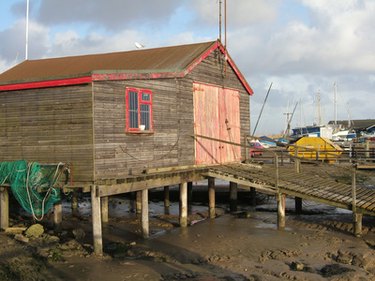
Stilt houses are also called pile dwellings, because rods or poles are driven into the ground to sustain the structure. These rods, poles or stilts are properly referred to as piles. Piles are made from several different types of materials, and sometimes two different materials may be used for one pile. The type of pile used is dependent on the foundation that is best suited for the type of structure being built.
Timber Pilings
Video of the Day
Timber pilings have been used for 6,000 years and continue to be one of the leading types of driven piles. Timber is often used in pile foundations because it is a readily available and renewable resource. Because it is light in weight, timber is also more easily handled, driven and cut than other types of piles. Timber piling is resistant to acidic and alkaline soil and does not corrode in such soils as easily as steel. According to the Federal Highway Administration, timber pile foundations installed underwater will last indefinitely and timber piles partially above water can last up to 100 years or longer if they are properly prepared and treated.
Video of the Day
Concrete Pilings
There are several variations of concrete piles. Concrete piles can be pre-cast or cast-in-place, and may be reinforced, pre-stressed or plain. Concrete piles do not corrode like steel piles or decay like wood piles and concrete is more readily available than steel. Pre-cast concrete piles are shaped and molded according to shape, length and size prior to being driven into the ground, while cast-in-place piles are poured into holes in the ground where a rod has been previously driven and removed. Reinforced and pre-stressed concrete piles are pre-cast piles: the concrete is poured over steel rods to make the pile stronger and better able to withstand the pressure of being driven into the ground.
Steel Pilings
Steel pilings are used more frequently in bridge construction than as home foundations. Steel pilings can be formed into many different shapes but the most common steel pile types have rolled circular, X-shaped or H-shaped cross sections. They are very strong and are great for driving, especially in firm soil. They can be easily cut off and joined by welding. Although steel pilings can last up to 100 years, they are prone to corrosion, especially when submerged in water. Sometimes steel piles are coated with tar before being driven to help protect against corrosion.
Composite pilings
Composite pilings are made with two materials in the same pile; one material is in the bottom portion of the pile and the other is in the top portion. These pilings make it possible to have the best of both worlds. For example, a timber piling that is susceptible to damage from insects can be installed underground while a concrete pile could be installed above ground level.